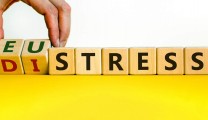Management training offers essential tools and strategies to address these challenges head-on, enforcing that leaders must be able to employ strategic approaches to managing both eustress and distress effectively. This is to help create a resilient and productive work environment.
Join us to unravel what they both mean, whilst presenting some practical techniques for achieving both in leadership roles.
Understanding Eustress and Distress
The chances are, although you’re no doubt familiar with the concept of stress (aren’t we all in this complex age?) there’s certainly one term in that heading you probably won’t be familiar with. And no, it doesn’t mean stresses related to the United Kingdom leaving the EU.
In this article, we’ll define both terms, differentiate them, and examine how each contributes to a positive or negative workplace environment and organisational culture.
We’ll also look at how managers and leaders can help recognise the difference.
Defining Eustress and Distress
Distress is something we colloquially understand as mental pain and anguish but there’s a scientific definition of distress too.
Distress, according to the American Dictionary of Psychology, is defined as “the negative stress response, often involving negative affect and physiological reactivity: a type of stress that results from being overwhelmed by demands, losses, or perceived threats.”
Eustress, by contrast, is described in the same publication as “the positive stress response, involving optimal levels of stimulation: a type of stress that results from challenging but attainable and enjoyable or worthwhile tasks.”
And let’s define the root term stress too. That’s described as “the physiological or psychological response to internal or external stressors.”
So, what we’re examining here is two very different types of stress response to external stimuli – one that’s beneficial, and one that’s detrimental, and potentially seriously harmful.
.jpeg)
Another way of understanding these terms is to imagine them as poles on either side of a stress continuum. Eustress, or positive stress, lies at one end, and distress is at the other.
Differentiating Between Eustress and Distress
A lot of common workplace situations involve stress: a high-stakes presentation, a product launch, an approaching deadline, a rumour of redundancies. All of these events, which involve uncertainty, can cause stress to build within a team or an individual.
As a leader, learning to recognise the difference between eustress and distress is a vital skill, allowing you to manage difficulties before they become crises, and appreciate the extraordinary efforts your team is making.
Let’s look at the differences between these two stresses and learn how to make this important distinction. We can best do this by asking a series of questions about the situation the stressed individual(s) finds themselves in.
1: How much uncertainty is there?
Eustress: the stressful situation has finite boundaries. You can answer the question “What’s the worst that could happen?” and the answer isn’t calamitous. This means the level of uncertainty about the outcome, though stressful, should be manageable.
Distress: there are no boundaries to the uncertainty. A rumour of redundancies could cause distress if there’s no clarity about the decision-making process, the scale of the redundancies, remuneration, or timescale. If it’s impossible to know the likely outcome, then distress may follow.
2: Can the stressed individual control the outcome?
Eustress: the problem lies broadly within the individual’s purview and expertise. Although challenging and stressful, the situation can be brought under control with the right focus, effort, and teamwork.
Distress: the individual feels there’s nothing they can do. Experiencing a lack of control is a major contributor to stress. Without control, you can’t formulate a plan, and you can’t address the crisis at hand. Importantly, for distress, it need only be the case that the individual feels powerless. In reality, they may have more control than they think.
3: Is the situation stable, or getting rapidly worse?
Eustress: the situation, although challenging, remains at a steady level of difficulty, or gets easier with time and experience. Think about attending a job interview, delivering a sales pitch, or reconciling a budget. Problems exist but are limited in scope.
Distress: it feels like the situation is spiralling out of control. When the stressed individual puts one fire out, two others spring up. There’s an inability to prioritise and everything they do is reactive, rather than proactive. Problems proliferate and the situation worsens.
4: Does the individual have sufficient support?
Eustress: Although challenged, the stressed individual can delegate to others or share responsibilities with peers. Their line manager is supportive and will provide additional resources when needed.
Distress: The stressed person feels alone and unsupported. They either have nobody to share responsibility with or don’t feel they can ask their manager for resources. They have “the weight of the world on their shoulders.”
5: To what extent do they feel threatened?
Eustress: Though there may be threats (managerial disapproval, lack of a bonus, redundancy) the individual under stress doesn’t see these as a significant threat to their wellbeing. They have a Plan B if all goes wrong.
Distress: The individual (at least physiologically) may feel as if their life is endangered. The “fight or flight” response is engaged, and they may lash out at others or start demonstrating avoidant behaviour.
This last point is key and may explain many of the outward indicators of stress: sweating, heart palpitations, shortness of breath, and even nosebleeds. We are, after all, evolved mammals, and a primitive part of our brain still reacts as it would encountering a sabre-toothed tiger or rival tribesman! The body doesn’t know whether the danger is truly life-threatening and begins to make physiological changes that would allow us to fight or run away.
Here, in summary, are the main differences between Eustress and Distress:
EUSTRESS: Manageable, finite, energising, controllable, POSITIVE
DISTRESS: Unmanageable, uncertain, debilitating, worsening, NEGATIVE
Strategies for Managing Eustress and Distress
Fortunately, there are a host of strategies we can employ to reduce the negative effects of stress, whether it’s of the positive or negative kind. Some of these we can practise in the moment when we might react badly to a stressor.
Others have to be learnt over a period of time, hopefully resulting in an overall reduction in stress levels.
Stress Prevention Techniques
The first set of techniques focus on methods of stress prevention, rather than reduction or coping in the moment.
1: Get More Organised
A lot of workplace stress, particularly in leadership roles, stems from a feeling of being overwhelmed by the scale of the challenge, or the sheer number of tasks that must be completed.
A great way to diminish stress is to become more systematic about addressing challenges. The use of calendar apps, spreadsheets, do lists, project management tools, GANTT charts, and other methods help break down the seemingly gargantuan into finite steps and processes.
Fortunately, there are an increasing number of systems out there to help organise and prioritise tasks, including platforms like Trello, Monday, Asana, and others. Learn to use these systems to plan your week, rather than work in a reactive, ad hoc, and chaotic manner, and your stress levels should diminish.

2: Learn to Delegate
You don’t have to do it all yourself. After all, what’s the point of being a leader if you can’t delegate a substantial amount of the vital tasks you must oversee to your team?
Avoid those control junkie tendencies to oversee every aspect of a piece of work and identify those colleagues you can trust to take on finite areas of responsibility. You may have to check up on them occasionally, but you won’t be spinning plates all day trying to manage everything at once.
If you are regularly in the office at 8pm, having arrived at 9am, the chances are you aren’t delegating enough. If you don’t have enough people in your team to handle everything, demand more resources.
3: Identify your Stressors
You may have particular bugbears that set you off, such as punctuality, inaccurate work, or problems in communication, but try to identify those that cause you most distress and see them for what they are – overreactions. If it is a problem in communication, why not find out which communication style you possess? And also check out these 8 Workplace Communication Styles.
While you do have to criticise members of your team for failing to live up to expected standards, you can do this without making it personal. This is where the age-old adage “count to ten” comes into play. Before sending that passive aggressive email, or raising your voice in a meeting, take a moment, and delay that knee-jerk response in favour of something more measured. The avoidance of conflict will help lower your stress level.
4: Take Time to De-Stress
At evenings, at weekends, and in the evening, try to maximise opportunities for relaxation or des-stressing activities like walks in nature, sports activities, restful naps, entertainment, or dinner with friends.
Whatever causes you personally to feel a sense of much-needed relaxation, build time into your week to do that. For some it’s walking the dog, while for others it’s wild swimming. Whatever works for you – go for it!
If your de-stressing activities are social, so much the better (though perhaps not with those angsty, stress inducing friends we all have one or two of).
5: Be Open and Honest
It might not work for every workplace, but for many modern working environments, it’s okay to admit to others that you’re stressed. For many colleagues, this will prove a source of relief (“I’m so glad I’m not the only one feeling it).
You may find this is where others step in and carry some of the load (remember tip 2) or where you put your heads together to figure out less stressful ways of working. It begins by being brave enough to admit there’s an issue.
6: Mindfulness and Meditation
Many people swear by these activities as fantastic ways to let the day’s stressors slip away into inconsequentiality. Mindfulness is simply a type of meditation where you sit and observe the contents of consciousness without thinking. Get adept at this activity and it’s said that worries, fears, and anxieties slip away.
Apps such as Calm, Waking Up and Headspace can help you practise and master this simple intervention, which can be enacted in ten-minute breaks in your day, perhaps at lunch or mid-afternoon.












Replies to This Discussion